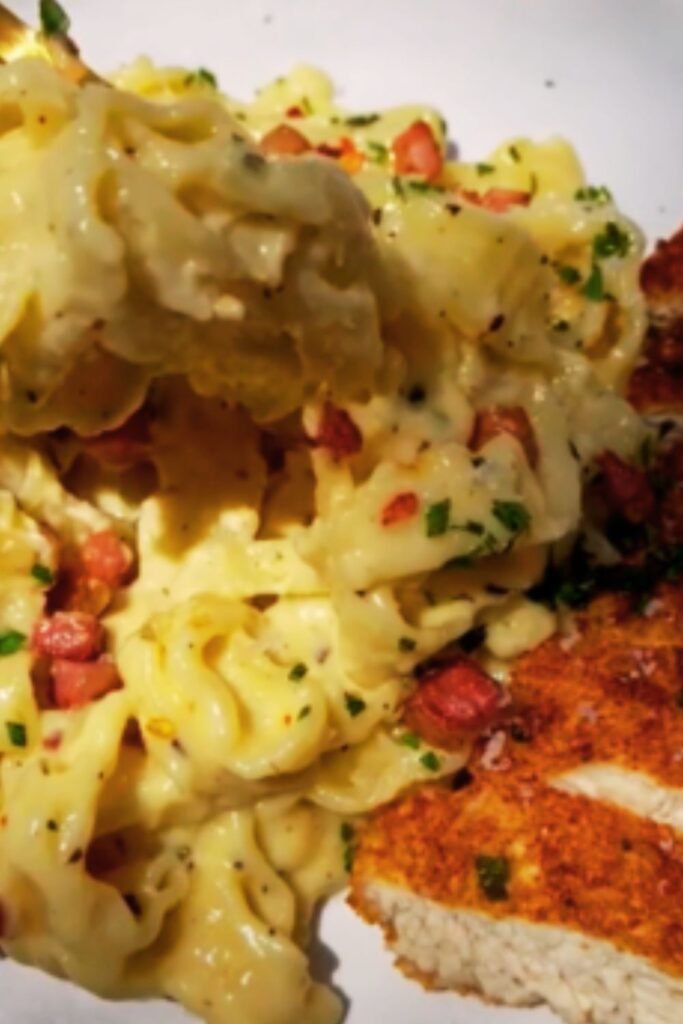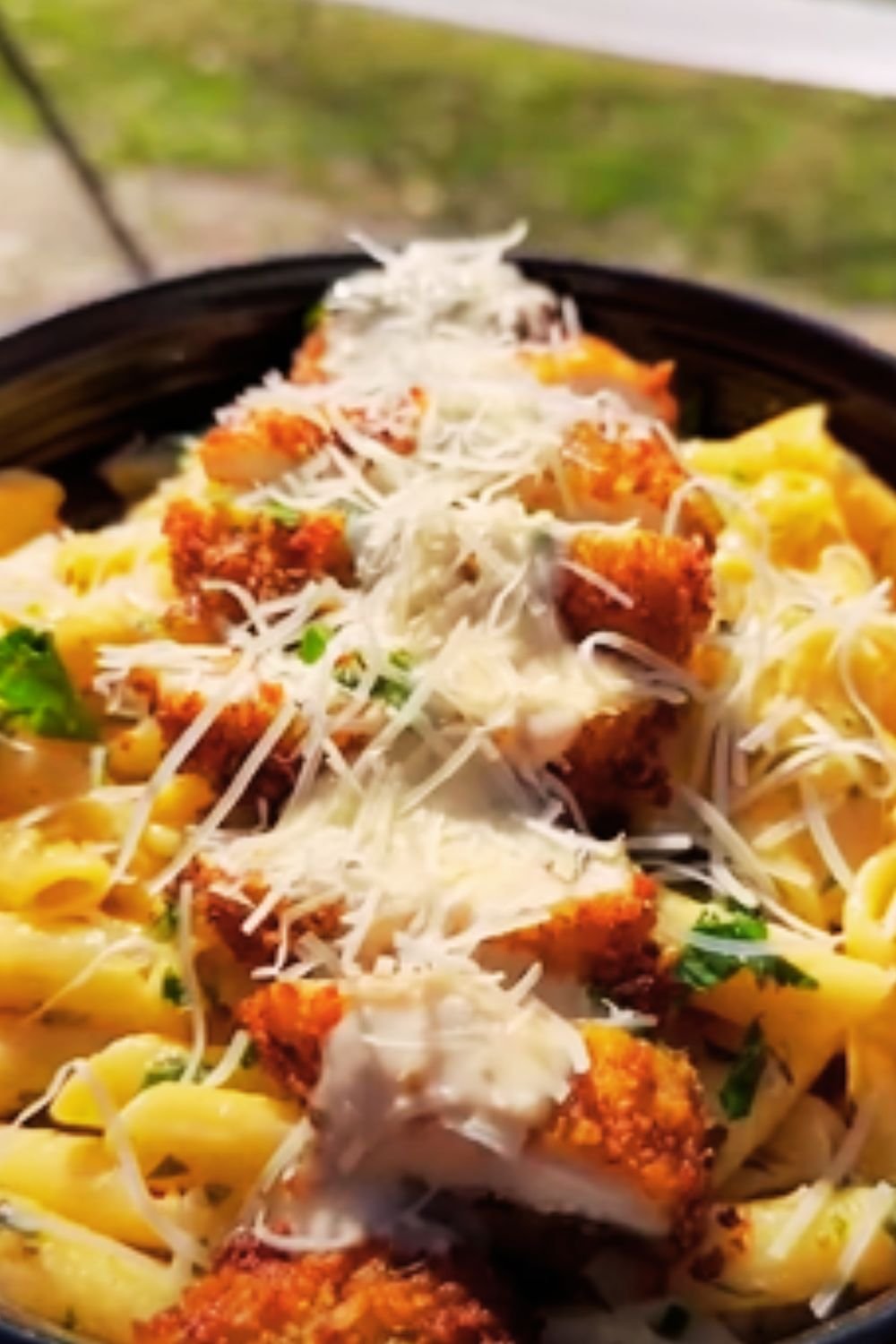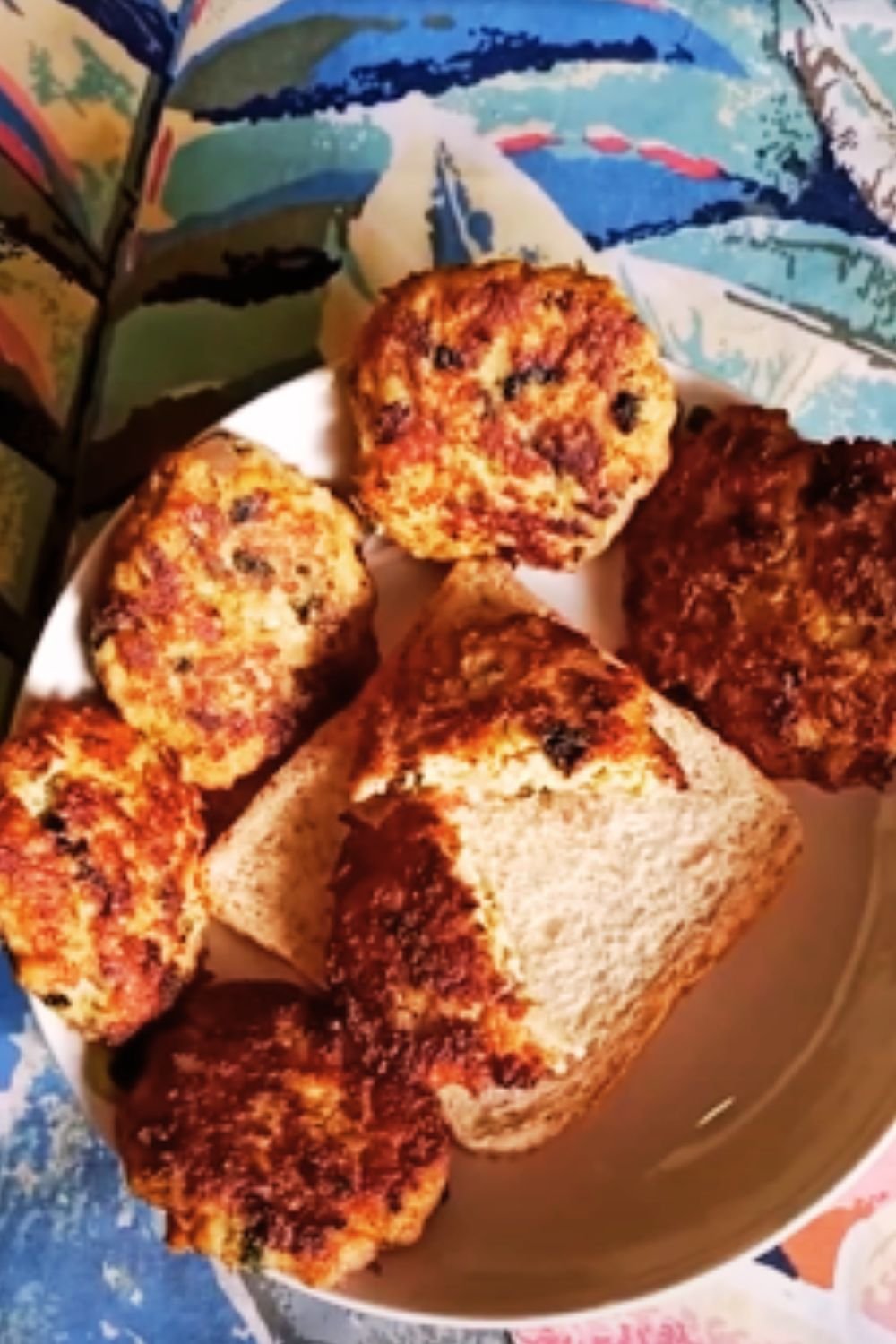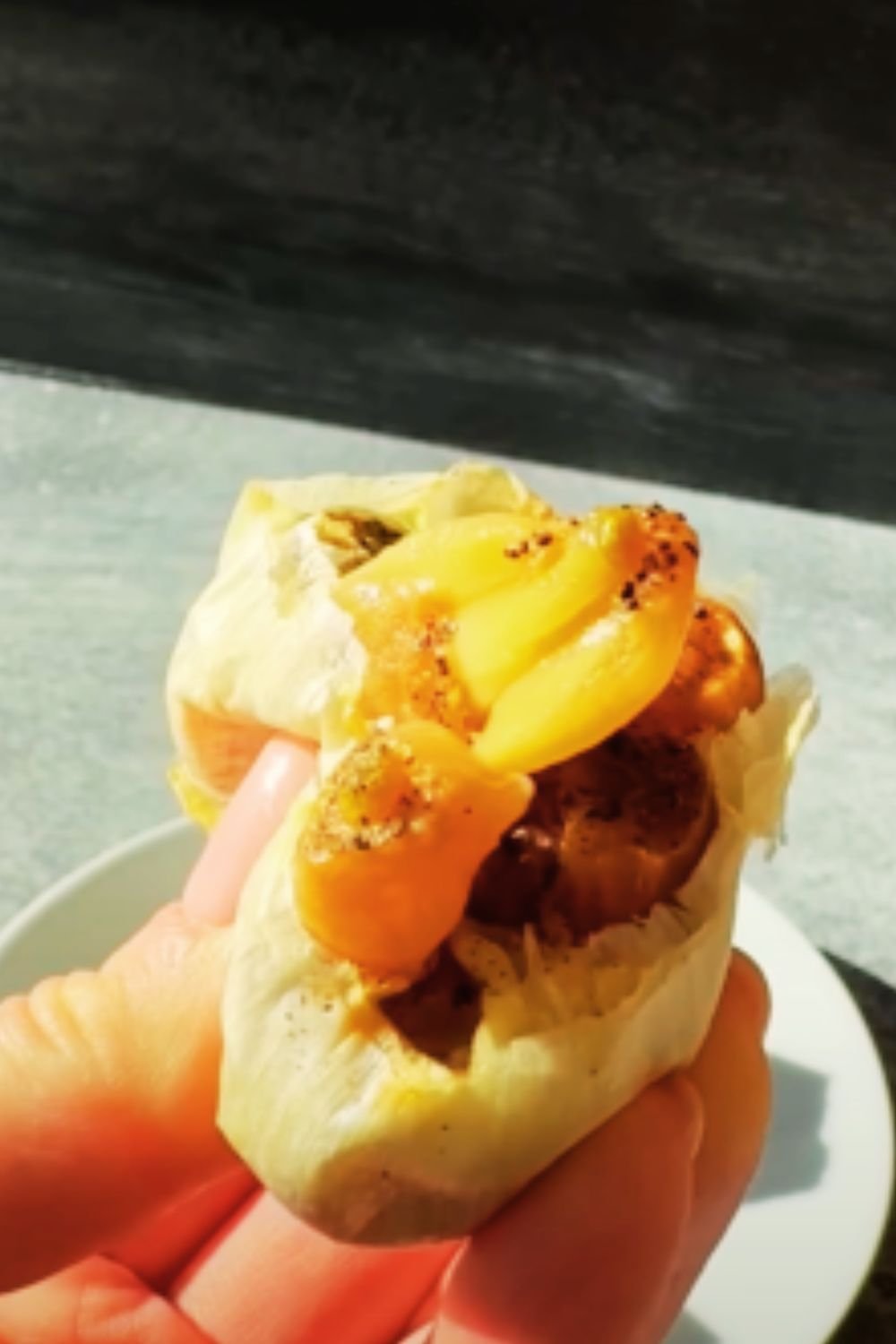There’s something magical about the combination of crispy, savory chicken coated in parmesan cheese paired with a silky, creamy alfredo sauce. It’s one of those dishes that manages to be both comforting and impressive at the same time. I’ve spent years perfecting this recipe, and today I’m excited to share my ultimate version with you.
When I first attempted making parmesan crusted chicken with alfredo, I encountered several challenges – chicken that wasn’t crispy enough, breading that fell off during cooking, and alfredo sauce that was either too thin or separated. Through trial and error, I’ve solved these issues and created a foolproof method that delivers restaurant-quality results every time.
Why This Recipe Works
Before diving into the steps, let me explain why this particular recipe stands out:
- The double-dredging technique ensures the coating stays on the chicken
- Using both panko breadcrumbs and parmesan creates the perfect texture contrast
- A touch of garlic powder and Italian herbs in the breading adds depth of flavor
- The alfredo sauce uses a combination of heavy cream and cream cheese for stability
- Cooking the chicken to the perfect internal temperature keeps it juicy
I’ve served this dish at countless dinner parties, and it never fails to impress. The beauty is in its versatility – it’s elegant enough for special occasions but simple enough for a weeknight dinner when you want something a bit more special.
Key Ingredients
Let’s break down what you’ll need to create this masterpiece:
For the Parmesan Crusted Chicken:
- Chicken breasts: 4 boneless, skinless (about 6-8 oz each)
- All-purpose flour: 1/2 cup
- Eggs: 2 large
- Panko breadcrumbs: 1 cup
- Parmesan cheese: 1 cup freshly grated (plus extra for garnish)
- Italian seasoning: 1 tablespoon
- Garlic powder: 1 teaspoon
- Salt: 1 teaspoon
- Black pepper: 1/2 teaspoon
- Olive oil: 3 tablespoons (for pan-frying)
For the Alfredo Sauce:
- Butter: 4 tablespoons (1/2 stick)
- Garlic: 4 cloves, minced
- Heavy cream: 2 cups
- Cream cheese: 4 oz, softened and cubed
- Parmesan cheese: 1 1/2 cups freshly grated
- Nutmeg: 1/8 teaspoon (freshly grated if possible)
- Salt and white pepper: to taste
For Serving:
- Fettuccine pasta: 1 pound
- Fresh parsley: 2 tablespoons chopped
- Cherry tomatoes: 1 cup halved (optional for color and freshness)
Equipment Needed
Having the right tools makes preparation much easier:
| Equipment | Purpose | Recommendation |
|---|---|---|
| Meat mallet | Tenderizing chicken to even thickness | Look for one with both flat and textured sides |
| Shallow dishes | For dredging station | Wide bowls or pie plates work well |
| Large skillet | For cooking chicken | Cast iron or stainless steel (at least 12-inch) |
| Instant-read thermometer | Checking chicken doneness | Digital for quick, accurate readings |
| Heavy-bottomed saucepan | For alfredo sauce | Choose one that distributes heat evenly |
| Whisk | For smooth sauce | Silicone-coated to protect your cookware |
| Large pot | For pasta | 6-8 quart size with lid |
| Tongs | For handling chicken and pasta | Silicone-tipped to prevent scratching |
Preparation Steps
Step 1: Prepare the Chicken
The foundation of this dish is properly prepared chicken breasts. I’ve found that taking the time to prep them correctly makes all the difference.
- Place the chicken breasts on a cutting board and cover with plastic wrap
- Using a meat mallet, gently pound the chicken to an even thickness of about 1/2 inch
- Pat the chicken dry with paper towels (this helps the coating adhere better)
- Season both sides with a pinch of salt and pepper
Pro tip: If your chicken breasts are particularly large, consider slicing them horizontally to create two thinner cutlets. This creates more surface area for the delicious parmesan crust.
Step 2: Set Up the Dredging Station
Creating an efficient dredging station before you start coating the chicken makes the process much cleaner and more organized.
- Set up three shallow dishes in a row
- In the first dish, place the flour
- In the second dish, beat the eggs with 1 tablespoon of water
- In the third dish, combine the panko breadcrumbs, grated parmesan, Italian seasoning, garlic powder, salt, and pepper
The science behind the dredging order: Flour first creates a dry surface for the egg to stick to. The egg then acts as glue for the breadcrumb mixture, ensuring you get a complete, well-adhered coating.

Step 3: Coat the Chicken
Now comes the fun part – creating that perfect parmesan crust!
- Take one chicken breast and dredge it in the flour, shaking off any excess
- Dip it into the beaten eggs, allowing any excess to drip off
- Press it firmly into the breadcrumb-parmesan mixture, ensuring an even coating on both sides
- Transfer to a clean plate and repeat with remaining chicken breasts
- For an extra-crispy coating, let the breaded chicken rest in the refrigerator for 15-30 minutes (this helps the coating set)
I’ve discovered that using one hand for dry ingredients and one for wet prevents the dreaded “breaded fingers” that can make this process messier than it needs to be.
Step 4: Cook the Chicken
Achieving that golden-brown crust while ensuring the chicken is perfectly cooked takes a bit of technique.
- Heat olive oil in a large skillet over medium heat until shimmering
- Add the chicken (working in batches if necessary to avoid overcrowding)
- Cook for 4-5 minutes on each side until golden brown and crispy
- Check that the internal temperature reaches 165°F (74°C) using a meat thermometer
- Transfer to a wire rack set over a baking sheet (this keeps the bottom from getting soggy)
- If needed, keep warm in a 200°F (93°C) oven while preparing the sauce
Why I use a wire rack: Setting the cooked chicken on paper towels can trap steam and soften that beautiful crispy crust. A wire rack allows air to circulate underneath, maintaining the texture we’ve worked so hard to achieve.
Creating the Perfect Alfredo Sauce
While the classic alfredo consists simply of butter, parmesan, and pasta water, I’ve found that a slightly more complex version pairs better with our parmesan crusted chicken and has more stability.
Step 5: Make the Alfredo Sauce
- In a medium saucepan, melt the butter over medium-low heat
- Add the minced garlic and sauté for 30-60 seconds until fragrant (but not browned)
- Pour in the heavy cream and bring to a gentle simmer (don’t boil)
- Reduce heat to low and add the cream cheese, whisking until melted and smooth
- Gradually add the grated parmesan, whisking constantly until completely incorporated
- Season with a pinch of nutmeg, salt, and white pepper to taste
- Simmer gently for 3-5 minutes until the sauce coats the back of a spoon
The key to silky smooth alfredo: Add the cheese gradually off the heat, whisking constantly. This prevents the proteins from seizing up and creating a grainy texture. Also, always use freshly grated parmesan—pre-grated contains anti-caking agents that can affect the sauce texture.
Step 6: Cook the Pasta
Perfectly cooked pasta is essential for completing this dish.
- Bring a large pot of water to a rolling boil
- Add 1-2 tablespoons of salt (the water should taste like the sea)
- Add the fettuccine and cook according to package directions until al dente
- Before draining, reserve 1 cup of pasta water
- Drain the pasta but do not rinse
Why reserve pasta water? The starchy water can be used to thin the alfredo sauce if it becomes too thick. It also helps the sauce adhere to the pasta better than plain water would.

Bringing It All Together
Now comes the most satisfying part – assembling all the components into a beautiful, delicious meal.
Step 7: Assemble the Dish
- Toss the hot pasta with about 3/4 of the alfredo sauce
- If the sauce is too thick, add a splash of reserved pasta water to reach desired consistency
- Divide the pasta among warmed serving plates
- Slice the parmesan crusted chicken diagonally and place atop the pasta
- Spoon remaining alfredo sauce over the chicken or on the side
- Garnish with additional grated parmesan, freshly ground black pepper, and chopped parsley
- Add halved cherry tomatoes around the plate for color and freshness if desired
I like to slice the chicken at a slight angle – it creates a more attractive presentation and shows off that juicy interior contrasted with the crispy coating.
Nutritional Information
For those keeping track of nutritional values, here’s a breakdown per serving (assuming 4 servings):
| Nutrient | Amount | % Daily Value* |
|---|---|---|
| Calories | 950 | – |
| Total Fat | 58g | 74% |
| Saturated Fat | 32g | 160% |
| Cholesterol | 285mg | 95% |
| Sodium | 1350mg | 59% |
| Total Carbohydrate | 56g | 20% |
| Dietary Fiber | 3g | 11% |
| Sugars | 3g | – |
| Protein | 52g | 104% |
*Percent Daily Values are based on a 2,000 calorie diet.
Serving Suggestions
This dish is truly a star on its own, but if you’re looking to create a complete meal, here are some complementary sides:
- Garlic bread: The perfect vehicle for sopping up extra alfredo sauce
- Roasted asparagus: The slight bitterness balances the richness of the dish
- Caesar salad: A classic pairing with creamy pasta dishes
- Steamed broccoli: Adds color and nutritional balance
- Sautéed spinach with garlic: A light side that cuts through the richness
For a family-style meal, I like to place the pasta in a large serving bowl with the sliced chicken arranged on top, allowing everyone to help themselves. This creates a impressive centerpiece for your table.

Make-Ahead and Storage Tips
I understand that sometimes you need to prepare components in advance or store leftovers. Here’s how to handle that:
Make-Ahead Options:
- Chicken preparation: Pound and season the chicken up to 24 hours ahead; store covered in refrigerator
- Breadcrumb mixture: Can be prepared up to 3 days ahead; store in airtight container
- Breaded chicken: Can be breaded up to 3 hours ahead; store uncovered in refrigerator (this actually helps the coating set better)
- Alfredo sauce: Can be made up to 2 days ahead and refrigerated; reheat gently with a splash of cream to reconstitute
Storing Leftovers:
| Component | Storage Method | Duration | Reheating Instructions |
|---|---|---|---|
| Cooked chicken | Refrigerate in airtight container | 3-4 days | Reheat in 350°F oven for 10-15 minutes until warmed through |
| Alfredo sauce | Refrigerate in airtight container | 3-4 days | Reheat gently on stovetop with extra cream to reconstitute |
| Complete dish | Refrigerate in airtight container | 2-3 days | Reheat covered in 325°F oven for 20 minutes |
| Freezing | Not recommended | – | Sauce may separate and chicken loses crispness |
Note: The chicken will lose some of its crispness when stored, but placing it in a hot oven for a few minutes can help restore some of the texture.
Troubleshooting Common Issues
Even experienced cooks encounter challenges. Here are solutions to common problems:
Chicken Issues:
- Breading falls off during cooking: Ensure chicken is dry before dredging; press coating firmly; allow to rest before cooking
- Chicken is browning too quickly: Lower heat; finish in 350°F oven if needed
- Chicken is dry: Don’t overcook; use meat thermometer to reach exactly 165°F
Alfredo Sauce Issues:
- Sauce is too thick: Add reserved pasta water or cream, a tablespoon at a time
- Sauce is too thin: Simmer longer; add extra parmesan
- Sauce is grainy: Remove from heat before adding cheese; use freshly grated parmesan
- Sauce separates when reheating: Reheat gently with additional cream, whisking constantly
Variations to Try
Once you’ve mastered the basic recipe, consider these delicious variations:
- Herb-Enhanced: Add fresh basil, thyme, or rosemary to the breadcrumb mixture
- Spicy Version: Add crushed red pepper flakes to the alfredo sauce
- Stuffed Parmesan Chicken: Create a pocket in the chicken and fill with spinach and mozzarella before breading
- Mushroom Alfredo: Sauté 8 oz of sliced mushrooms before adding garlic to the sauce
- Lemon Twist: Add 1 teaspoon lemon zest to the breadcrumb mixture and a squeeze of lemon juice to brighten the finished dish
I particularly enjoy the herb-enhanced version in the summer when fresh herbs are abundant in my garden. The fragrance is absolutely intoxicating!
Frequently Asked Questions
Q: Can I use chicken thighs instead of breasts? Absolutely! Boneless, skinless chicken thighs work beautifully in this recipe. They’re actually more forgiving as they don’t dry out as easily. Just trim excess fat and pound to even thickness.
Q: Is there a way to make this dish lighter? Yes, you can use half-and-half instead of heavy cream, reduce the amount of cheese slightly, and bake the breaded chicken at 425°F with a light spray of cooking oil until golden and cooked through.
Q: Can I make this gluten-free? Definitely! Substitute the all-purpose flour with rice flour and use gluten-free panko breadcrumbs. Also ensure your pasta is gluten-free.
Q: My sauce always breaks when reheating. How can I prevent this? Reheat the sauce very gently over low heat, stirring constantly. Adding a splash of fresh cream helps re-emulsify the sauce. Never microwave alfredo sauce.
Q: Can I add vegetables to make this a one-dish meal? Great idea! Steamed broccoli, peas, or sautéed spinach mix beautifully with the pasta and sauce. Add them to the pasta just before serving.
Q: What’s the best way to grate parmesan for this recipe? Always use a microplane or the fine side of a box grater for the sauce to ensure it melts properly. For the breading, slightly coarser grating is fine.
Q: My chicken always ends up soggy on the bottom. How can I prevent this? After cooking, place the chicken on a wire rack rather than directly on a plate. This allows air to circulate and prevents steam from softening the coating.
Final Thoughts
Parmesan crusted chicken with alfredo is truly one of those special dishes that brings together simple ingredients to create something extraordinary. The contrast between the crispy, savory chicken and the smooth, creamy sauce creates a perfect balance of


